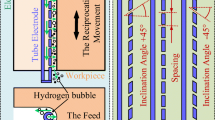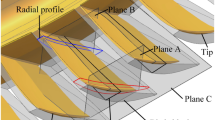Abstract
Electrochemical machining (ECM) is an effective method for machining a blisk. Because a blisk often has several tens to hundreds of blades and only one channel can be machined at a time using current methods, the machining time is long. A highly efficient ECM method for machining the channels of a blisk using multiple tube electrodes is presented. The method involves the synchronous movement of several designed metal tube electrodes toward the workpiece for the simultaneous electrochemical machining of multiple channels. To optimize the flow fields, different shapes of the electrolyte outlet were designed for the tube wall, namely, a continuous outlet in the form of a long and narrow slit and intermittent outlets comprising multiple holes or slits. The distribution of the groups of holes or slits was optimized. The simulation results showed that the electrolyte outlet mode of the multiple slits was more suitable. To determine the optimal parameters of the ECM process, experiments were performed using different electrolytes, outlet shapes, and feed rates. It was found that the developed electrolyte outlet could be used to enhance the machining stability and the quality of the produced blisk. An integrated blisk was finally machined using the proposed method.
Similar content being viewed by others
References
Bußmann M, Kraus J, Bayer E (2005) An integrated cost-effective approach to blisk manufacturing. Proceedings of 17th Symposium on Air Breathing Engines
Klocke F, Zeis M, Klink A, Veselovac D (2012) Technological and economical comparison of roughing strategies via milling, EDM and ECM for titanium- and nickel-based blisks. Procedia CIRP 2:98–101
Fujisawa T, Inaba K, Yamamoto M (2008) Multiphysics simulation of electrochemical machining process for three-dimensional compressor blade. J Fluid Eng 130(8):1–8
Paczkowski T, Sawicki J (2008) Electrochemical machining of curvilinear surfaces. Mach Sci Technol 12(1):33–52
Brusilovski Z (2008) Adjustment and readjustment of electrochemical machines and control of the process parameters in machining shaped surface. J Mater Process Technol 196:311–320
Tsuboi R, Yamamoto M (2010) Modeling and applications of electrochemical machining process. IMECE2009 4:377–384
Xu ZY, Sun LY, Hu Y, Zhang JC (2014) Flow field design and experimental investigation of electrochemical machining on blisk cascade passage. Int J Adv Manuf Technol 71(1–4):459–469
Klocke F, Zeisa M, Harsta S, Klinka A, Veselovaca D, Baumgärtner M (2013) Modeling and simulation of the electrochemical machining (ECM) material removal process for the manufacture of aero engine components. 14th CIRP Conference on Modeling of Machining Operations (CIRP CMMO)
Curtis DT, Soo SL, Aspinwall DK (2009) Electrochemical superabrasive machining of a nickel-based aeroengine alloy using mounted grinding points. CIRP Ann 58(1):173–176
Lee ES, Won JK, Shin TH (2012) Investigation of machining characteristics for electrochemical micro-deburring of the AZ31 lightweight magnesium alloy. Int J Precis Eng Manuf 13(3):339–345
Dhobe SD, Doloi B, Bhattacharyya B (2011) Surface characteristics of ECMed titanium work samples for biomedical applications. Int J Adv Manuf Technol 55:177–188
Senthilkumar C, Ganesan G, Karthikeyan R (2009) Study of electrochemical machining characteristics of Al/SiCp composites. Int J Adv Manuf Technol 43:256–263
Kim BH, Na CW, Lee YS (2005) Micro electrochemical machining of 3D micro structure using dilute sulfuric acid. CIRP Ann 54(1):191–194
Tang L, Guo YF (2013) Experimental study of special purpose stainless steel on electrochemical machining of electrolyte composition. Mater Manuf Process 28(4):457–462
Sharma S, Jain VK, Shekhar R (2002) Electrochemical drilling of Inconel superalloy with acidified sodium chloride electrolyte. Int J Adv Manuf Technol 19:492–500
De Silva AKM, Altena HSJ, McGeough JA (2003) Influence of electrolyte concentration on copying accuracy of precision-ECM. CIRP Ann 52(1):165–168
Fan ZW, Hourng LW, Lin MY (2012) The influence of electrochemical micro-drilling by short pulsed voltage. Int J Adv Manuf Technol 61:957–966
Ghoshal B, Bhattacharyya B (2013) Influence of vibration on micro-tool fabrication by electrochemical machining. Int J Mach Tool Manuf 64:49–59
Coteaţă M, Schulze HP, Slătineanu L (2011) Drilling of difficult-to-cut steel by electrochemical discharge machining. Mater Manuf Process 26(12):1466–1472
Nguyen DM, Rahman M, Wong YS (2013) Modeling of radial gap formed by material dissolution in simultaneous micro-EDM and micro-ECM drilling using deionized water. Int J Mach Tool Manuf 66:95–101
Judal KB, Yadava Y (2013) Cylindrical electrochemical magnetic abrasive machining of AISI-304 stainless steel. Mater Manuf Process 28(4):449–456
Judal KB, Yadava Y (2013) Experimental investigations into electrochemical magnetic abrasive machining of cylindrical shaped nonmagnetic stainless steel workpiece. Mater Manuf Process 28(10):1095–1101
Zhu D, Zeng YB, Xu ZY (2011) Precision machining of small holes by the hybrid process of electrochemical removal and grinding. CIRP Ann 60(1):247–250
Shaikh JH, Jain NK, Venkatesh VC (2013) Precision finishing of bevel gears by electrochemical honing. Mater Manuf Process 28(10):1117–1123
De Silva AKM, Pajak PT et al (2014) Modeling and experimental investigation of laser assisted jet electrochemical machining. CIRP Ann 53(1):179–182
Author information
Authors and Affiliations
Corresponding author
Rights and permissions
About this article
Cite this article
Xu, Z., Liu, J., Xu, Q. et al. The tool design and experiments on electrochemical machining of a blisk using multiple tube electrodes. Int J Adv Manuf Technol 79, 531–539 (2015). https://doi.org/10.1007/s00170-015-6815-x
Received:
Accepted:
Published:
Issue Date:
DOI: https://doi.org/10.1007/s00170-015-6815-x




